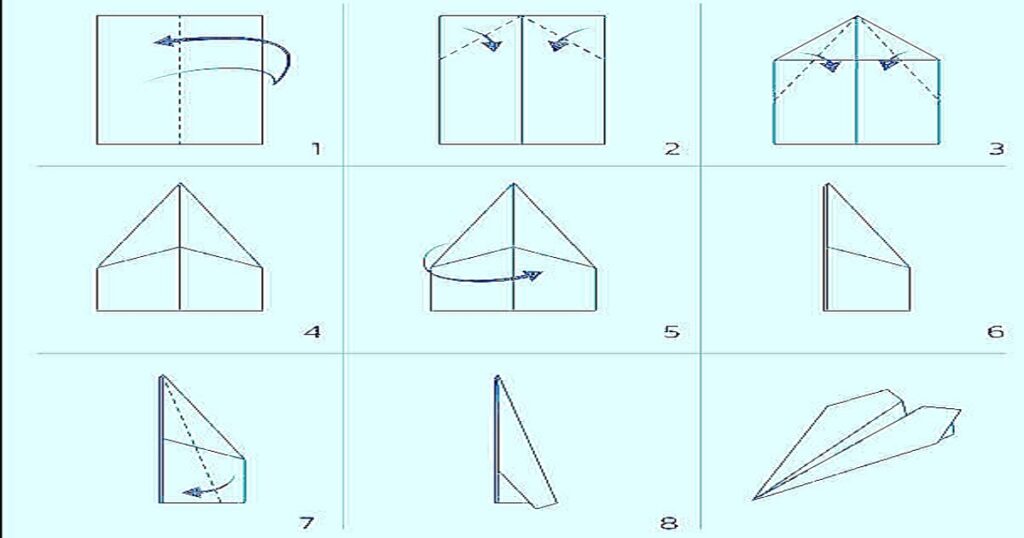Paper Airplane: Who doesn’t love a good paper airplane? It’s a classic pastime that combines fun and creativity, perfect for all ages. In this guide, we’ll explore everything you need to know about making paper airplanes, from the basics to advanced designs, tips for optimizing performance, and even the educational benefits. Ready to become a paper airplane pro? Let’s dive in!
History of Paper Airplanes
Paper airplanes have a rich history dating back to ancient China and Japan, where paper was first invented. These early paper gliders were simple yet fascinating, eventually evolving into more complex designs. Over the centuries, paper airplanes have captured the imaginations of both children and adults, serving as both toys and tools for studying aerodynamics.
Materials Needed
Before we get started, let’s gather our materials. The great thing about making paper airplanes is that you don’t need much:
Paper: Standard letter-size paper (8.5 x 11 inches) works perfectly. You can also experiment with different weights and textures.
Additional Tools: Optional items include markers for decorating, a ruler for precise folds, and scissors for custom shapes.
Basic Paper Airplane Design
Let’s start with the classic dart design, a favorite for its simplicity and impressive flight. Follow these steps:
- Fold the paper in half lengthwise to create a crease and then unfold it.
- Fold the top corners down to meet the center crease, forming a triangle.
- Fold the triangle down so that the top point meets the bottom edge.
- Fold the top corners again to the center crease, forming a sharper triangle.
- Fold the remaining triangle upwards to lock the corners in place.
- Fold the paper in half along the initial crease.
- Fold the wings down so they line up with the bottom edge of the plane.
- Your classic dart is ready for takeoff!

Advanced Paper Airplane Designs
Ready to take your paper airplane skills to the next level? Try these advanced designs:
Glider Design
- Fold the paper in half to create a crease, then unfold.
- Fold the top edges to the center crease to form a triangle.
- Fold the top point down to the bottom edge.
- Fold the top corners to the bottom center.
- Fold the new top point down to the bottom edge.
- Fold the paper in half along the center crease.
- Fold the wings down to create wide, flat wings.
- Loop and Stunt Plane Design
- Fold the paper in half lengthwise, then unfold.
- Fold the top corners to the center crease to form a triangle.
- Fold the top point down to the bottom edge.
- Fold the top corners again to the center crease.
- Fold the remaining triangle up to lock the corners.
- Fold the paper in half along the center crease.
- Fold the wings down at a slight angle to create a loop effect.
Step-by-Step Guide for a Glider Plane
For a glider plane that floats gracefully through the air:
- Start with a piece of paper and fold it in half lengthwise.
- Unfold the paper and fold the top edges to the center crease.
- Fold the top point down to meet the bottom edge.
- Bring the top corners down to the center again.
- Fold the top point down to the bottom edge once more.
- Fold the paper in half along the center crease.
- Fold the wings down, ensuring they are wide and flat for better gliding.
- Tips: Make sure the wings are symmetrical and the creases are sharp for optimal flight.
Step-by-Step Guide for a Stunt Plane
For a plane that can perform tricks and loops:
- Begin with a piece of paper folded in half lengthwise.
- Unfold and fold the top corners to the center.
- Fold the top point down to the bottom edge.
- Fold the top corners to the center again.
- Lock the corners by folding the remaining triangle up.
- Fold the paper in half along the center crease.
- Create the wings by folding them down at an angle.
- Tips: Adjust the wing angles to change the plane’s flight pattern and perform various stunts.
Decorating Your Paper Airplane
Why not add some flair to your paper airplane? Here are a few creative ideas:
- Markers and Colored Pencils: Draw patterns, logos, or fun designs.
- Stickers and Stamps: Add some texture and extra visual interest.
- Custom Shapes: Cut the wings into unique shapes for a personalized touch.
Optimizing Flight Performance
To make your paper airplane fly better, consider these tips:
- Balance: Ensure the plane is evenly balanced by checking the symmetry of your folds.
- Adjustments: Small tweaks to the wings and body can greatly improve flight.
- Aerodynamics: Smooth, sharp creases help reduce air resistance and improve performance.
Troubleshooting Common Issues
Is your plane nosediving or veering off course? Here are some solutions:
- Nosediving: Adjust the wings upwards slightly.
- Veering Left or Right: Check for symmetry and make sure both wings are evenly folded.
- Poor Flight: Ensure the creases are sharp and the folds are precise.
Paper Airplane Competitions
Did you know there are competitions for paper airplane enthusiasts? Here are some popular types:
- Distance: How far can your plane fly?
- Time Aloft: How long can your plane stay in the air?
- Accuracy: Can you hit a target?
- Tips for Winning: Practice makes perfect. Experiment with different designs and techniques to find what works best.
Educational Benefits of Making Paper Airplanes
Making paper airplanes isn’t just fun—it’s educational too! Here’s how:
- Physics and Aerodynamics: Learn about lift, drag, and other principles of flight.
- Creativity and Problem-Solving: Designing and tweaking planes fosters creativity and critical thinking.
- Fine Motor Skills: Folding paper precisely helps improve dexterity.
Fun Facts about Paper Airplanes
- The world record for the longest paper airplane flight is over 226 feet!
- Some paper airplane designs date back over a thousand years.
- There are museums dedicated to the art of paper folding, including paper airplanes.
Conclusion
Making a paper airplane is a simple yet rewarding activity that anyone can enjoy. From basic designs to advanced models, there’s always something new to learn and try. So grab a piece of paper and start folding—who knows, you might just create the next record-breaking plane!
FAQs
What is the best type of paper for making paper airplanes? Standard letter-size paper (8.5 x 11 inches) is ideal. Experimenting with different weights and textures can also be fun.
How can I make my paper airplane fly farther? Ensure your folds are precise and sharp. Adjust the wings for better balance and aerodynamics.
Why does my paper airplane keep crashing? Check for symmetry and make sure all folds are even. Small adjustments to the wings can help correct flight issues.
Can I decorate my paper airplane without affecting its flight? Yes, decorating with markers or stickers is a great way to personalize your plane without affecting its performance. Are there official paper airplane competitions? Yes, there are many competitions worldwide focusing on distance, time aloft, and accuracy.












